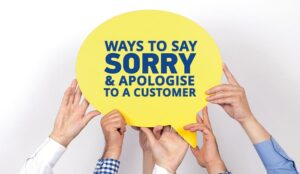Jodie Rhodes at EvaluAgent explains how to fix seven examples of bad customer service.
You’re already aware that customer service is key to the success of your business. Helping your customers to find the right path to exactly what they need means striving to create a good customer service experience at every opportunity.
Bad customer service can be frustrating and costly for everyone involved. Time and money can be wasted, and both new and existing customers are all too easily lost as a result of bad customer service.
What Is Bad Customer Service?
If a customer feels that they have received bad customer service, it’s highly likely that their expectations have not been met. Although bad customer service will mean different things to different customers, there are a number of examples that show up time and time again.
Bad customer service not only has the capacity to damage the relationship between your business and your existing customers, it can also prevent you from gaining new customers – both of which can have serious implications for your financial success.
You’ll want to ensure that you avoid gaining a reputation for bad customer service at all costs. In today’s incredibly competitive marketplace, customers are quick to judge a business and often won’t be willing to give you a second chance.
Here are 7 examples of bad customer service – and some useful tips to help you fix them:
1. Hold Times Are Too Long
One of the most common examples of bad customer service is keeping customers on hold for too long. This can be an incredibly frustrating experience for any customer – wasting their valuable time and making them feel undervalued.
Increasingly, customers (especially the younger demographic) simply aren’t prepared to wait and will either:
- turn to other channels of communication to get in touch instantly
- find another company that offers better access to answers and services as and when needed.
Whilst it’s inevitable that you will encounter times when call volumes are high and demand is challenging, there are ways to fix long hold times and the effect they have on customer experience. These can include:
- Providing an automated response to let the customer know the approximate wait time
- Analysing data to work out your busiest times to rota staff accordingly
- Offering a call back service at busy times to avoid your customers having to wait on hold
2. Too Many Call Transfers
Many customers are already frustrated upon making a call as it’s often a last resort after they haven’t been able to remedy a problem themselves or find the information that they need online.
It’s therefore essential that, upon calling your business, customers are immediately directed to someone who can help them efficiently with their specific requirement. Transferring a customer between different departments where they are often asked to repeat data or security questions is a prime example of bad customer service.
There are a number of steps you can take to improve customer service when it comes to this issue:
- Make sure that you have as much helpful information online as possible so that the customer can find access to what they’re looking for independently.
- Ensure all your agents have access to customer data in a centralised location so that it doesn’t have to be passed to or requested between departments
- Optimise the efficiency of any call handler by training them to deal with any type of call and customer request
3. Not Empathising With Customers
A customer who has called for help is likely to already be frustrated at not being able to resolve an issue they have encountered independently. Regardless of the reason for their call, it’s essential that call handlers and agents are sympathetic and understanding to customers.
This is one of the easiest bad customer service examples to put right – it doesn’t require expensive technology or higher staffing levels. All you need to do is ensure that your agents are fully trained in how to empathise with customers.
There are lots of ways to help your agents become more empathetic when handling calls to your business such as:
- Role-playing different situations and ensuring that agents play the part of a customer with a frustrating issue
- Giving feedback on specific conversations that agents may have had and offering examples as to how they could have increased their empathy with the customer
4. Rude Behaviour and Bad Attitudes
There’s no excuse for rude behaviour and bad attitudes within a business. Customers deserve to be treated with respect in any given situation and will quickly turn away from your business if they experience bad attitudes from staff.
The reputation of your business is closely linked to the customer’s experience of good service so you don’t want to jeopardise how you’re perceived by having agents acting impolitely.
Why not consider some of the following options when it comes to fixing rude behaviour and bad attitudes?
- Taking a zero-tolerance approach to direct rudeness: if any agents are found to have used abusive or inappropriate language to customers this should be dealt with immediately.
- Discuss appropriate language and tone of voice with agents: lines can get blurred when a customer claims an agent has been rude to them, so make sure anyone in your company is using appropriate language and has been fully trained in the tone of voice expected for customer communication.
5. Avoiding Responsibility
Everyone makes mistakes, and customers will generally be understanding of miscommunications or misunderstandings.
However, bad customer service occurs when businesses shirk responsibility and refuse to admit any errors.
It’s important that your agents are fully trained to deliver authentic apologies to any customer who may have had a bad experience or not had exceptional customer service. This can help to repair relationships and retain customers who may otherwise take their business elsewhere.
6. Overpromising and Underdelivering
This is an example of bad customer service that can affect businesses of all sizes, across industry sectors.
There’s a fine line between wanting to keep customers happy and being able to deliver on any promises made. It’s really important that call handlers do not over promise – whether they’re trying to recruit a new customer or remedying a problem for an existing one.
Clear communication and expectation management is essential to avoid the pitfall of overpromising and under delivering.
Agents must be confident in the full details of services that they can offer to customers – this includes giving accurate time scales for when requests will be met.
7. Not Following Up
Once you’ve done the hard work of gaining new customers, it’s so important that you ensure that they’re happy with the service they’re experiencing by following up with them. Many businesses simply don’t follow up with customers – leaving them feeling undervalued and unhappy.
Following up with customers or potential customers can also be an excellent way of gaining valuable feedback.
By checking in with them via a phone call with an engaged and empathetic agent, your business can get insightful data into which parts of the business they are happy with or where they see improvements to be made.
Taking the initiative to follow up with customers will help to solidify their view of your business as accessible, caring and relatable – which may just help you beat the competition.
Turn Your Back on Bad Customer Service
As you can see, there are endless examples of bad customer service and as a business there are pitfalls that you want to avoid at all costs.
We believe that a great employee experience is the key to being able to offer a great customer experience.
With help, it’s easy to turn your back on bad customer service.
Author: Guest Author
Published On: 20th Feb 2023
Read more about - Guest Blogs, EvaluAgent



































